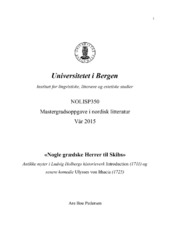| dc.contributor.author | Pedersen, Are Bøe | eng |
| dc.date.accessioned | 2015-06-18T06:54:26Z | |
| dc.date.available | 2015-06-18T06:54:26Z | |
| dc.date.issued | 2015-05-14 | |
| dc.date.submitted | 2015-05-14 | eng |
| dc.identifier.uri | https://hdl.handle.net/1956/10009 | |
| dc.description.abstract | Masteroppgave i nordisk litteratur Institutt for lingvistiske, litterære og estetiske studier, Universitetet i Bergen Mai 2015 Student: Are Bøe Pedersen Veileder: Pål Bjørby Tittel: «Nogle grædske Herrer til Skibs» Undertittel: Antikke myter i Ludvig Holbergs historieverk Introduction (1711) og senere komedie Ulysses von Ithacia (1725) Denne masteroppgaven undersøker Ludvig Holbergs bruk av antikk mytologi i de to første kapitlene av hans tidlige historiske arbeid Introduction til de Fornæmste Europeiske Rigers Historier (1711) og den senere komedien Ulysses von Ithacia (1725), en parodi av den samtidige, tyske musikkdrama-tradisjonen. Forbindelsen mellom verkene, tross ulike sjangre, er flere. Foruten Holberg selv, deler de en motivkrets av gresk og romersk mytologi, og inngår i en større dialog Holberg fører gjennom forskjellige deler av sitt forfatterskap, om helter og konseptet heroisme. De tilsynelatende motsetningene mellom hvordan Holberg fremhever historiske skikkelsers «heroiske» bedrifter i Introduction, med måten det heroiske kritiseres i Ithacia, belyses fra flere vinkler. Den teoretiske bakgrunnen for analysen er Bals mytekritiske narratologi, Ricoeurs beskrivelser av «rom» i (mytisk) fiksjon, og endelig Foucaults epistem-begrep, derunder epistemiske brudd. Motsetningene kan forklares først som et utslag av hvordan den eneveldige styresmakten i Holbergs samtid bruke de antikke heltemytene som en form for selv-representasjon, slik at myte- og heltekritikk fikk en dimensjon av allegorisk regimekritikk. Dette devaluerte imidlertid de mytologiske heltene, og Holberg etablerer derfor egne kriterier for en type helt som kan adskilles fra sin mytologiske kontekst - noe Holberg også gjør med Alexander den store i Introduction. Dette representerer et brudd med samtidens stadig kommuniserte idé om de antikke mytenes underforståtte sentralitet. Min lesning av Ithacia konkluderer med at komedien ikke «bare» parodierer tysk drama, men at Holberg i sin harselas med ulike myteuniverser, konstruerer et nytt mytologisk univers. Dette universet er enhetlig og bryter ikke sammen på tross av en rekke interne geografiske og kronologiske motsetninger, som i stedet har en destabiliserende effekt på de «opprinnelige» universene. Dermed illustrerer Ithacia gjennom en rekke brudd at både at skottene mellom forskjellige, etablerte myteuniverser slett ikke er tette, og at de antikke mytene er plastiske, og kan formes etter fortellingens og fortellerens behov. | en_US |
| dc.description.abstract | MA thesis in Nordic Literature Department of Linguistic, Literary and Aesthetic Studies, University of Bergen May 2015 Student: Are Bøe Pedersen Advisor: Pål Bjørby Title: «Nogle grædske Herrer til Skibs» Subtitle: Classical myth in Ludvig Holberg's historical work Introduction (1711) and later comedy Ulysses von Ithacia (1725) This thesis examines Ludvig Holberg's use of Classical myth in the two initial chapters of his early historical work Introduction til de Fornæmste Europeiske Rigers Historier (1711) and the later comedy Ulysses von Ithacia (1725), the latter parodying the contemporary German tradition of musical drama. These works are connected not only through Holberg himself, but also through the thematic emphasis on Greek and Roman mythology, and by being part of Holberg's authorship-wide debate concerning heroes and the concept of heroism. The apparent contradictions between Introduction's emphasis on the «heroic» deeds of certain historical figures with Ithacia's scathing indictment of heroism is explored from various angles. The theoretical foundation of the analysis encompasses Bal's myth-critical narratology, Ricoeur's description of «spaces» in (mythical) fiction, and finally Foucault's notion of the episteme and epistemic breaks. The contradictions can be explained initially as a consequence of contemporary absolutist regimes employing classical, heroic myth as a form of self-representation; thus inadvertently turning the critique of myth and heroes into a venue for political criticism, shielded by a veneer of allegory. This came at the cost of devaluing the mythological hero, in turn causing Holberg to establish a personal set of heroic criteria, allowing for the separation of heroes from their mythical context, as he does with Alexander the Great over the course of Introduction. This represents a significant break with the contemporary idea of the unstated centrality of classical myth. My reading of Ithacia concludes that it moves beyond parody: Over the course of making a mythological farce by mixing Classical, Biblical and local mythology, Ithacia establishes a new, original mythology. This fresh mythological universe does not crumble under the weight of its internal geographical and chronological inconsistencies. Its very imperviousness to these inconsistencies instead works to destabilize the internal integrity of and boundaries between the various myths, forcing an epistemic break by trouncing their assumed primacy and inviolate status, and demonstrating their inherent plasticity in the hands of a narrator. | en_US |
| dc.format.extent | 618913 bytes | eng |
| dc.format.mimetype | application/pdf | eng |
| dc.language.iso | nob | eng |
| dc.publisher | The University of Bergen | eng |
| dc.rights | Copyright the author. All rights reserved | eng |
| dc.subject | Holberg | eng |
| dc.subject | Introduction | eng |
| dc.subject | Ulysses von ithacia | eng |
| dc.subject | Historie | eng |
| dc.subject | Komedie | eng |
| dc.subject | Myte | eng |
| dc.subject | Bal | eng |
| dc.subject | Ricoeur | eng |
| dc.subject | Foucault | eng |
| dc.subject | Rorty | eng |
| dc.title | «Nogle grædske Herrer til Skibs» - Antikke myter i Ludvig Holbergs historieverk Introduction (1711) og senere komedie Ulysses von Ithacia (1725) | eng |
| dc.type | Master thesis | |
| dc.description.degree | Master i Nordisk språk og litteratur | |
| dc.description.localcode | MAHF-NORD | |
| dc.description.localcode | NOLISP350 | |
| dc.subject.nus | 711123 | eng |
| fs.subjectcode | NOLISP350 | |
